Visit the Kitchen Gardens during The Edible Garden
Posted in Exhibitions, Exhibitions, The Edible Garden, Video on July 30 2010, by Plant Talk
 |
Rustin Dwyer is Visual Media Production Specialist at The New York Botanical Garden. |

Inside The New York Botanical Garden
Posted in Exhibitions, Exhibitions, The Edible Garden, Video on July 30 2010, by Plant Talk
 |
Rustin Dwyer is Visual Media Production Specialist at The New York Botanical Garden. |
Posted in Exhibitions, The Edible Garden on July 29 2010, by Plant Talk
The New York Botanical Garden and Whole Foods Markets® have partnered to promote and support local food and sustainable agriculture through weekly cooking demonstrations. Each Friday at 2 p.m. during The Edible Garden, a chef from Whole Foods Market® presents innovative seasonal recipes using fresh ingredients at the Conservatory Kitchen.
July’s grilling theme comes to a close with today’s event. In August the cooking demonstrations will focus on healthy eating, including Whole Foods Market’s Health Starts Here program. The bountiful harvest takes the spotlight on Fridays in September and October.
Click on the video to view a recent Whole Foods Market® Fridays presentation. Then come and see for yourself in person. The event is included in the Weekday ticket.
Posted in Exhibitions, The Edible Garden on July 28 2010, by Plant Talk
Hear how Mario Batali uses pine nuts, learn how to cook zucchini flowers, find out how to use sweet potatoes in desserts, and garner more culinary tips by tuning in to the informative Celebrity Chef Audio Tour.
Augment your visitor experience during The Edible Garden by listening to several chefs, including Dan Barber, Michael Psilakis, and Sara Moulton, discuss a variety of delectable fruits and vegetables—how they grow and how you can use them in cooking.
You’ll also hear gardening advice from Botanical Garden staff members Annie Novak, coordinator of the Children’s Gardening Program, and Karen Daubmann, Director of Exhibitions and Seasonal Displays.
Do you have a story of your own about a particular vegetable or fruit that you’d like to share? Leave a message for others to hear. You can get links to recipes and growing tips sent directly to your cell phone as well.
To listen to the audio tour, look for the audio tour symbol and phone number on signs throughout the Garden grounds or call from home, 718.362.9561. Enter the prompt number you wish to listen to followed by the # key. (For instance, Mario Batali on pine nuts is 240#). Enter another prompt number at any time followed by the # key.
For a list of topics and numbers, click here. Better yet, come visit The Edible Garden and experience the tour in person.
Posted in Exhibitions, The Edible Garden on July 23 2010, by Plant Talk
Demonstration Shows How to Put Up Your Own at Home
 |
Eugenia Bone is a veteran food writer and author of Well-Preserved. She will present canning demonstrations at The Edible Garden Conservatory Kitchen on July 25 at 1 and 3 p.m. |
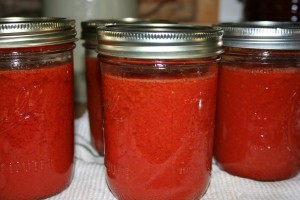 You may remember your grandmother putting up fruits in glass jars. Well, that practice is alive and well in New York City today, and it’s as safe and easy as it ever was.
You may remember your grandmother putting up fruits in glass jars. Well, that practice is alive and well in New York City today, and it’s as safe and easy as it ever was.
The motivation for urban and suburban canning is to have foods on hand to eat off-season (as well as for health, economic, and environmental reasons). All you have to do is decide what you’d really like to have stocked in the cupboard. People often ask me what is a good starter product for the beginner canner. I always say, whatever you like to eat! For me, that’s tomatoes. But to make it manageable, I put up a couple of pints at a time, when I am cooking dinner and hanging around the kitchen anyway.
Though tomatoes are a fruit, they have a pH usually of 4.5 or 4.6, which is just on the borderline of foods you can safely process in a water bath. For this reason, the Feds recommend you acidify all tomato products. You can use 2 tablespoons of lemon juice per pint, but I prefer a 1/4 teaspoon of citric acid. I buy 4-ounce jars of NOW citric acid online (www.nowfoods.com, keyword “citric acid”), and that does the trick of acidifying tomatoes beautifully.
I can tomatoes two ways, depending on how much time I have.
Posted in Exhibitions, The Edible Garden on July 20 2010, by Plant Talk
Soil and Seasons Are Key, Says Stone Barns Farm Manager
 |
Jack Algiere is the Four-Season Farm Manager at Stone Barns Center for Food and Agriculture in Pocantico Hills, New York. He co-curated one of The Edible Garden’s Celebrity Chef Kitchen Gardens with Dan Barber, Executive Chef and Co-Owner of Blue Hill. |
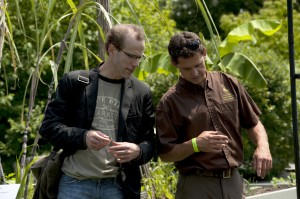 As we dance our way through the seasons, Dan Barber (pictured left with me) reminds me often that I (the farmer) lead the way. If this is so, I have learned all my moves from watching and imitating the nimble flow of nature. Whether the tarantella or a tomato salad, the principles remain the same: communication and respect.
As we dance our way through the seasons, Dan Barber (pictured left with me) reminds me often that I (the farmer) lead the way. If this is so, I have learned all my moves from watching and imitating the nimble flow of nature. Whether the tarantella or a tomato salad, the principles remain the same: communication and respect.
Understanding the fundamentals of the soil and the seasons is key to growing delicious food for nourishing and inspiring meals. At Stone Barns, we rely on several principles to maintain balance in our ecosystem, and these principles can guide the home gardener as well.
First, recognize that the whole of nature exhibits diversity and change. In the garden we replicate this through a balanced rotation of diversified crops. My preference is to diversify by plant families such as the nightshade, legume, mustard, or chicory.
Posted in Exhibitions, Learning Experiences, The Edible Garden on July 16 2010, by Plant Talk
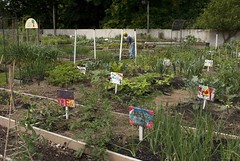 From digging in the Children’s Vegetable Garden to pretending to harvest fruits and vegetables at the Farm-to-Table play station, it’s easy for families to make a connection with food while having fun during The Edible Garden, which runs through October 17. From digging in the Children’s Vegetable Garden to pretending to harvest fruits and vegetables at the Farm-to-Table play station, it’s easy for families to make a connection with food while having fun during The Edible Garden, which runs through October 17.
Explore nature in the Everett Children’s Adventure Garden
Gardening fun in the Ruth Rea Howell Family Garden
All proceeds of The Edible Garden benefit the Children’s Gardening program. |
Posted in Exhibitions, The Edible Garden on July 15 2010, by Plant Talk
Chef Inspired by Greenmarket; Gives More Cooking Demos this Weekend
 |
Trish Sebben-Krupka is Corporate Chef for the Viking Culinary Center and Carl Schaedel and Co., and owner of Local Girl Makes Food, a culinary education and personal chef business. Her recipes appear in The Best of Vegan Cooking. She will present cooking demonstrations at The Edible Garden’s Conservatory Kitchen July 17 and August 14 at 1 and 3 p.m. Viking is a Supporting Sponsor of The Edible Garden. |
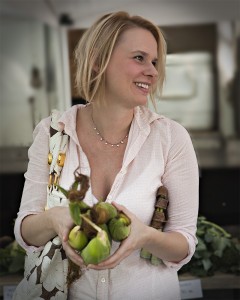
I pulled into the Garden’s Mosholu gate last Wednesday, excited to return to the Greenmarket. With five basic pantry ingredients and $25, I planned to see how far we could stretch this budget into delicious, family-friendly meals. My pantry included salt, pepper, olive oil, red wine vinegar, and hot sauce, things that are ordinarily found in just about any home kitchen.
I wandered through the Greenmarket, accompanied by Adriana Pecunia, my friend and fellow chef. Our $25 was spent quickly, and we walked away with a bag brimming with fresh corn, tiny new potatoes, red onions, flat romano green beans, tomatoes, parsley, cilantro, purslane, gold ball squash, zucchini, basil, carrots, and a petite baguette. I also managed to talk one of the farmers into making a deal on two quarts of tart red cherries.
We then made our way to the Conservatory Kitchen, where people were seated awaiting our Cooking for Your Health demonstration despite the incredible midday heat. I was excited to see that the high school-aged participants in the Botanical Garden’s GardenWorks program had joined us, as I love to show young people new foods and cooking techniques. This program, in partnership with the Bronx Institute’s Gear Up program, introduces students to new experiences and career choices in botanical science, horticulture, and education.
Adriana and I got cooking right away, making a light and healthful vegetable soup with onions, carrots, potatoes, green beans, zucchini, and corn, along with some fresh herbs and my favorite ingredient of the day: tart, lemony, purslane.
Posted in Exhibitions, The Edible Garden on July 14 2010, by Plant Talk
| Written by Burpee Home Gardens Team. Burpee is a Supporting Sponsor of The Edible Garden. |
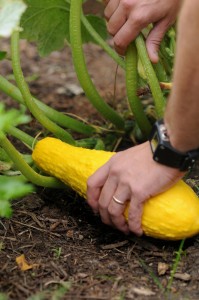 The interesting thing about home vegetable gardens (and one that experienced gardeners learn to perfect), is that they evolve with the seasons. From cool to warm to hot, and back again, each of these cycles provides an opportunity to plant different crops for a maximized garden harvest.
The interesting thing about home vegetable gardens (and one that experienced gardeners learn to perfect), is that they evolve with the seasons. From cool to warm to hot, and back again, each of these cycles provides an opportunity to plant different crops for a maximized garden harvest.
One of the best-loved varieties that supply multi-seasonal recipes at your table is the trusty squash. We love the fact that you can grow a squash for almost every holiday recipe, from the Fourth of July cookout to Christmas dinner. Whether in the salad bowl or on the grill, in soup or in bread, squash can do it all. You can even eat squash blossoms—cooked or raw! Blossoms are a special treat reserved for only the best restaurants (and home gardeners) because of their perishable and delicate nature. But best of all, squash is one of the easiest and most prolific vegetables you can plant in your garden, and with success.
Native to the Americas, squash can be divided into two types: summer and winter. Summer squashes ripen quickly (as fast as 50 days). Winter squashes and their hard rinds ripen later. Summer squashes such as yellow, crookneck, and zucchini are eaten soon after harvesting—skin and all. They’re great eaten raw (with vegetable trays), steamed, grilled, or boiled. You can stuff them and bake them or grate larger-sized ones for delicious and flavorful breads. Winter squashes such as acorn and butternut, are often cut in half and baked, or boiled and then mashed like potatoes.
Posted in Exhibitions, The Edible Garden on July 9 2010, by Sonia Uyterhoeven
Chef Keith Snow Grows His Own; Shares Secrets, Tips
 |
Keith Snow is a TV host, cookbook author, and creator of Harvest Eating.com; he will present cooking demonstrations at The Edible Garden on July 11. |
Many Americans want to take part in the harvest revolution and eat foods grown at home to ensure freshness, good taste, and reasonable cost. But what if you live in an apartment building—are you out of luck? Actually, no. Many people who live in urban areas around the country are taking part in the local food craze by growing food in containers.
Before you run out to the nursery to get started, consider whether your balcony or rooftop can handle the weight and whether your building permits it: A large container of wet soil can weigh 50–100 pounds or more. Multiply that by the number of containers you’d like, and check whether your site can handle the extra load. (If regulations do not allow for you to grow outdoors, you can certainly grow herbs indoors near a sunny window.)
Once you’ve resolved where to place your plants, you’ll need to decide what to grow. Some plants are perfectly suited to containers, others are not. I like to advise people to create a kitchen garden in containers that can produce herbs, lettuces, tomatoes, cucumbers, eggplant, and peppers. These crops can thrive in containers and provide a lot of food and recipe diversity.
Posted in Exhibitions, The Edible Garden on July 8 2010, by Plant Talk
 |
Cathy Erway, author of The Art of Eating In, will present cooking demonstrations at The Edible Garden Conservatory Kitchen on Saturday, July 10, at 1 and 3 p.m.. |
 Perhaps you’ve tried them at Korean restaurants, with spicy kimchee in the batter. Maybe you’ve heard of them and guessed they were more or less like scallion pancakes at Chinese restaurants, but with more stuff. Maybe you’ve even taken a crack at making them at home, with strips of leftover meat or seafood. In any case, you are probably well aware of how simple yet delicious a crisp, savory pancake hot off the pan can be. I’ve found that holds true with almost any ingredient you mix into the batter.
Perhaps you’ve tried them at Korean restaurants, with spicy kimchee in the batter. Maybe you’ve heard of them and guessed they were more or less like scallion pancakes at Chinese restaurants, but with more stuff. Maybe you’ve even taken a crack at making them at home, with strips of leftover meat or seafood. In any case, you are probably well aware of how simple yet delicious a crisp, savory pancake hot off the pan can be. I’ve found that holds true with almost any ingredient you mix into the batter.
My favorite way to enjoy savory pancakes, though, is just with fresh veggies. Red onions and apples is a wildly satisfying combo in the winter. Shredded carrots and parsnips go great together, too. But in the summer, the vibrant flavors of everything that’s in season can’t be beat. Try making the pancakes with thinly sliced peppers of all shades and mixing fresh corn into the batter along with scallions and another type of onion. For the recipe below, I use a filling of mostly shredded zucchini.